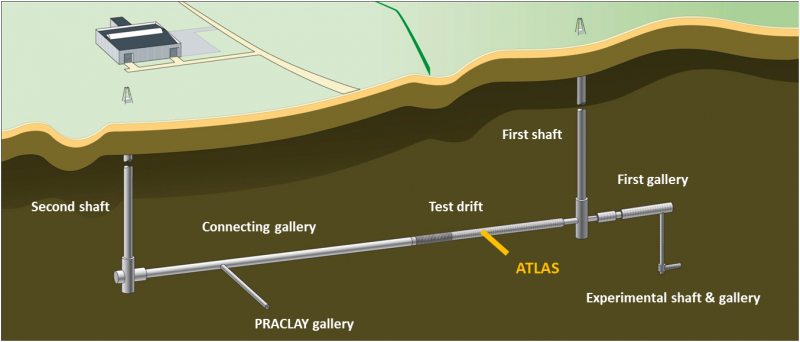ATLAS (1992-2012)
|
|
|
Admissible Thermal Loading for Argilaceous Storage
Vitrified high-level radioactive waste and spent fuel generate considerable amounts of heat. After disposal in a geological repository, the host formation will be subject to significant temperature gradients. In a low-permeable clay formation, due to the differential rate of thermal expansion of the solid phase and water, an increase in temperature will temporarily generate excess pore water pressures. These in turn cause hydraulic gradients and a change in effective stresses that significantly affect the hydraulic and mechanical behaviour of the clay. To assess the hydro-mechanical effects of the thermal transient on the Boom Clay, various in-situ heating tests have been performed in the HADES underground research laboratory, including the ATLAS heating tests.
OBJECTIVES
The in-situ ATLAS heating tests (phase I to phase IV) examined the integrated thermo-hydro-mechanical (THM) response of the Boom Clay at a distance of several metres from the heated borehole.
The specific objectives were:
- to verify that the thermally induced excess pore water pressure would not reach hydraulic fracture conditions and to thereby determine the admissible thermal loading for the Boom Clay;
- to confirm and update the THM characteristics of the Boom Clay, especially the anisotropic thermal and mechanical properties (observation boreholes were installed in directions parallel and perpendicular to the bedding plane of the Boom Clay);
- to prepare for the PRACLAY Heater test, a large-scale heater test in the Boom Clay to simulate the heat production around a disposal gallery on a representative scale.
OUTCOME
The tests provided a large set of good-quality, well-documented data on temperature, pore water pressure and total stress, which have been submitted to the European project TIMODAZ (2006–2010) for a modelling benchmark.
The measurements of the temperature field provided clear evidence of thermal anisotropy of the Boom Clay. Coupled THM numerical analyses were carried out and have enhanced understanding of the THM behaviour of the Boom Clay. Good agreement between the temperature and pore water pressure measured and the results obtained by numerical modelling yielded a set of anisotropic THM properties, which increases confidence in the capability of current THM-coupled constitutive laws and numerical codes to predict the evolution of temperature and pore water pressure in the far field of disposal galleries for heat-emitting waste.
SUMMARY
REFERENCE PUBLICATION
Chen G.J., Sillen X., Verstricht J., Li X.L. - ATLAS III in situ heating test in Boom Clay: Field data, observation and interpretation. - In: Computers and Geotechnics, 38(2011), pp. 683-696. - ISSN 0266-352X


